Bubble Wrap For Window Insulation
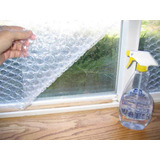
How To Save Money on Heating By Using Bubble Wrap Often used in green houses, bubble wrap can also be used on domestic windows to boost their insulation rating from R1 to R2. Try bubble wrap on your windows this winter and start saving money.
|
From builditsolar.com... This is a simple technique for insulating windows with bubble wrap packing material. Bubble wrap is often used to insulate greenhouse windows in the winter, but it also seems to work fine for windows in the house. You can use it with or without regular or insulating window shades. It also works for windows of irregular shape, which can be difficult to find insulating shades for. The view through the bubble wrapped window is fuzzy, so don't use it on windows where you need a clear view. But, it does let plenty of light through. People seem to like the medium to large size bubbles, but report of smaller bubbles having the same insulating properties are common. The larger ones appear (from surface temperature measurements) to insulate a little better, and you still get a nice artistic effect looking out of them. The small bubble wrap totally obscures the view, but you still get plenty of light. |
Installation
- Cut the bubble wrap to the size of the window pane with scissors.
- Spray a film of water on the window using a spray bottle.
- Apply the bubble wrap while the window is still wet and press it into place.
- The bubble side goes toward the glass.
- To remove the bubble wrap, just pull it off starting from a corner. You can save it and use it for several years. It does not leave a mess or stains on the window glass.
If you have trouble with the bubble wrap separating from the window when the film dries, you can try adding a little Glycerin to the water, but this probably won't be necessary.
A few small pieces of double back tape can be helpful on really stubborn windows.
The bubblewrap can be installed in autumn, and removed in spring. Judging by how mine looks after a year, it may last quite a while.
When you take the bubble wrap down, put a small number in on the upper right corner of each piece of bubble wrap, and write down which window that number goes with on a piece of paper. Save the paper for the installation next fall. This tells you instantly where each sheet goes, and which way its oriented.
Double Bubble
I thought it might be worth a try to see if two layers of bubble wrap might be used. This may be going a bit far, but it does seem to work. I applied a 2nd layer of bubble wrap over the first layer in exactly the same way as the first layer was applied to the window glass. That is, spray the first layer of bubble wrap with water mist, and while its still wet apply the 2nd layer of bubble wrap to it and smooth it out. For both layers, the bubble side face the glass. It has been a couple days since I did this, and it is staying in place OK -- not sure if it will stay up with the added weight in the long term or not. The two layers of bubble wrap fuzzy the view a bit more than one layer, but it still seems to transmit quite a bit of light. The surface temperature on the 2nd layer is higher than the surface temperature on the first layer, so it is adding some insulation value.
Payoff
The bubble wrap has a short payback in cold climates. About 2 months for single glazed windows, and half a heating season for double glazed widows. Details on payback: For an 7000 deg-day climate (northern US), and single glazed windows, the bubble wrap increases the R value from about R1 to about R2. This cuts the heat loss from the window in half. Heat losses with and without bubble wrap for 1 sqft of window are: Heat loss w/o wrap = (7000 deg-day)(1 ft^2) (24 hr/day) / (1 ft^2-F/BTU) = 168K BTU per season Heat loss with wrap = (7000 deg-day)(1 ft^2) (24 hr/day) / (2 ft^2-F/BTU) = 88K BTU per season If you are heating with natural gas at $1.50 per therm (100 CF) in an 80% efficient furnace, then the saving for 1 sqft of wrap for the season is: Saving per sqft = ($1.50)(168K - 88K)/(100K*0.8) = $1.65 per season per sqft of window The bubble wrap cost about $0.30 per sqft, so the payback period is about 2 months -- not too bad! If you repeat the numbers above for double glazed windows, the saving is $0.60 per sqft per season, and the payback period is a about one half heating season. If you use a more expensive fuel like propane, fuel oil, or electricity, the savings will be correspondingly more.
Bubble Wrap Life
Bubble wrap should last between 5 and 7 years on your windows. Please note that as the bubble wrap gets to the end of its insulating life, it may tend to stick to the glass. Accordingly, it's better to replace it at between 4 and 5 years just to be sure.
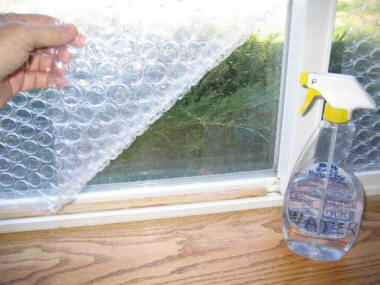 |
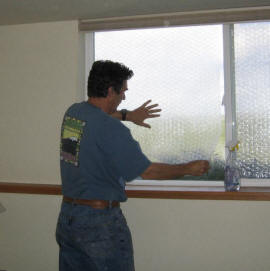 |
| Spray water on glass with bubble side toward glass | Smooth bubble wrap out so that water contact holds it in place. |
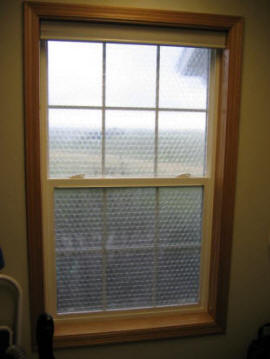 |
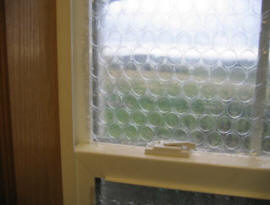 |
